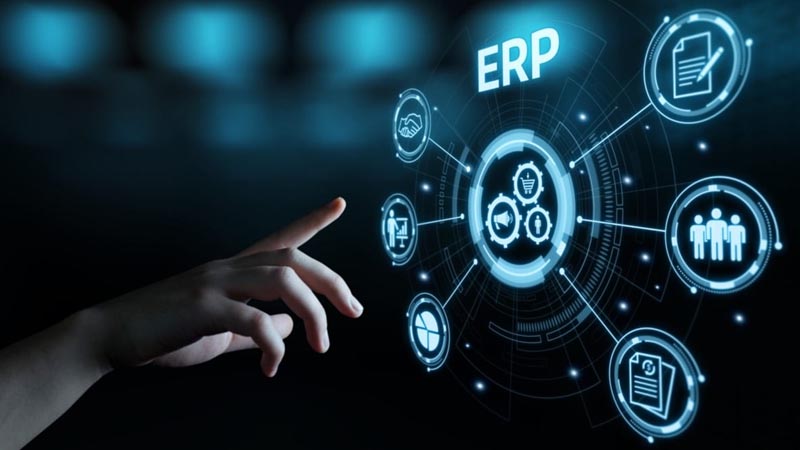Enterprise Resource Planning (ERP), sometimes known as an ERP system, is a suite of programmes used to handle crucial company functions and information. Organizations may be able to simplify their processes and increase production by better allocating, coordinating, and managing their available resources.
Accounting, human resources, inventory, the supply chain, and even customer service is just some of the areas that ERP systems may help with. These systems provide an enterprise-wide, shared database that is always up to date and accessible by all users.
ERP System Advantages:
1. No Room for Mistake
There is less room for mistake and less need for human intervention in the form of data entry because to the ERP system ability to automate formerly manual processes. As a result, operational efficiency is increased and employees have more time for strategic work.
2. Streamlined Operations
An ERP machine system may help businesses standardize and simplify their business processes, leading to uniformity between divisions and locations. This allows for higher levels of teamwork, which in turn increases productivity and delights clients.
3. Better Decision-Making
ERP system enable informed decision-making by providing real-time access to reliable data and generating reports and analytics. To make data-driven choices, business executives may receive insights into key performance metrics, monitor financials, check inventory levels, and analyses consumer patterns.
4. Greater Visibility with ERP System
An ERP machine system gives a comprehensive perspective of the organization’s activities by centralizing data from diverse departments and functions. This insight enables stakeholders to track performance, detect bottlenecks, and efficiently optimize resources.
5. Improved client Relationship Management
An ERP system has modules for managing client relationships, which enables firms to track interactions, manage sales leads, and deliver personalized customer support. This aids in the development of strong customer connections and the cultivation of consumer loyalty.
Comprehending Facility Management and Handling System:
A facility management system is a subset of enterprise resource planning (ERP) software that is designed to handle the organization’s physical spaces and assets. It aids in making the most of available space, keeping machinery in working order, planning preventative maintenance, and keeping tabs on legal and safety requirements.
Buildings, machines, furniture, and even water and electricity may all be more easily monitored and controlled with the help of a property management system. Asset information, maintenance records, warranty terms, and scheduled service appointments may all be stored in one convenient location. In doing so, businesses may better schedule maintenance efforts, reduce unplanned downtime, and maximize the useful life of their assets.
The Advantages of a Facility Management and Handling System:
1. Efficient Space Utilization
By tracking occupancy rates, monitoring workspace allocation, and identifying areas for improvement, a facility management system allows organizations to optimize their use of space. This can result in cost savings and increased production.
2. Streamlined Maintenance
A facilities management system assures timely inspections, repairs, and replacements by automating maintenance workflows and schedules. This decreases machine downtime, maintenance costs, and overall operational efficiency.
3. Compliance and Safety
By keeping accurate records of inspections, certifications, and maintenance operations, the system assists organizations in remaining compliant with regulatory standards and safety regulations. This lowers the likelihood of accidents and legal complications.
4. Improved Asset Performance
With a facility management system, businesses can track asset performance, analyses maintenance data, and spot wear and tear patterns. This enables preventative maintenance, lowering the likelihood of malfunctions and increasing asset longevity.
5. Data-driven Decision Making
A facility management and utilization system collect and analyses data on facility utilization, maintenance costs, and asset performance. This enables organizations to make data-driven choices, allocate resources more efficiently, and find areas for development.
Conclusion:
A company’s ability to simplify its operations, increase productivity, and make well-informed decisions is greatly aided by enterprise resource planning (ERP) solutions like facilities management software. ERP system offer efficient resource management through a consolidated perspective of the organization’s operations gleaned from data collected across departments and functions. ERP systems help to a company’s performance in many ways, including the management of money, human resources, and facilities. Investing in an enterprise resource planning (ERP) system is crucial for every firm that wants to survive and prosper in today’s cutthroat market.
Enterprise resource planning system is an effective method for businesses to improve efficiency, boost output, and differentiate themselves from the competition. Businesses may enhance collaboration, data quality, and operational efficiency by integrating several departments and operations into a single platform. As an offshoot of enterprise resource planning, the facility management and utilization system’s primary goals are efficiency in resource utilization, asset management, and regulatory compliance.
You may also like
-
Latest Technology: Why Are Mobile Games Changing the Way We Interact with the Digital World?
-
The Evolution of Storytelling in Video Games: From Pixels to Immersive Narratives
-
10 List of the Cheapest and Best Curved Type PC Monitors in 2024
-
The Role of Regulation Technology (RegTech) in Monitoring Online Color Prediction
-
How to Navigate Google Maps Transit Directions

